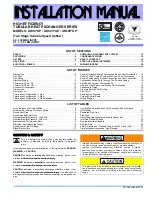
W415-1245 / B / 03.19.15
22
IOM
IOM
Horizontal vents should pass through the exterior wall. Figure 8 shows a standard horizontal vent detail.
Terminate the vent approximately 8” (203mm) or more from the wall.
Exterior vent pipe greater than 24” (610mm) should be insulated with 1/2” (13mm) insulation to prevent
moisture from freezing within the pipe and accumulating.
Size the exhaust pipe as speci
fi
ed in
Table 4 - Direct and Non-Direct Vent
Lengths
. This table lists the maximum
allowable length of pipe with respect to
the number of 90° elbows used. For the
purposes of this calculation, one 90°
elbow is equivalent to two 45° elbows.
Avoid locating the terminal in locations
where dripping condensate may cause
problems such as sidewalks, patios,
above planters, near windows where
exhaust gases may cause fogging, etc.
Avoid locating the termination too close
to shrubs and other vegetation. The
condensate may stunt or kill them.
EQUIVALENTS
Short Radius Elbow = 7 ft (2.13m)
Standard Radius Elbow = 5 ft (1.52m)
Long Radius Elbow = 3 ft (0.91m)
45 Degree Elbow = 2.5 ft (0.76m)
Vent lengths that require more than
6-90° elbows, add listed equivalents
for every elbow up to the maximum
allowable vent length.
9.1 VENT
TERMINATION
H14.0
Size the combustion air and exhaust piping in accordance
with Table 4. When calculating allowable vent lengths, be
sure to count all termination
fi
ttings in addition to counting the
concentric vent as a straight pipe.
Take the building orientation and the presence of other
buildings or other nearby structures into consideration
when planning the venting system location. Certain
external structures could create air turbulence around the
vent termination leading to downdrafts and similar venting
problems. In windy and hill locations, roof venting may improve
operations. Maximum venting length is based on 30 mph
(48 km) winds, areas where higher gusts are dominant it is
suggested to shorten the horizontal vent length.
The vent and combustion air intake shall be installed so that
both are located in the same wind pressure zone.
*3"
(76mm)
MIN.
12"
(305mm)
MIN.
INTAKE
EXHAUST
GRADE
*18" (457mm) MIN. FOR COLD
CLIMATES (SUSTAINED 0°F (-18°C)
FOR 24 OR MORE CONSECUTIVE
HOURS
FIGURE 8 - STANDARD (STRAIGHT)
HORIZONTAL VENT DETAIL
H3.13
DO NOT CONNECT FURNACE TO A CHIMNEY OR FLUE SERVING OTHER APPLIANCES OR A
SOLID FUEL BURNING APPLIANCE.
WARNING
!
!
TABLE 4 - DIRECT AND NON-DIRECT VENT LENGTHS
Maximum Allowable Length Of Exhaust Or Intake. Minimum Vent Length 15 ft.
(4.6m) or equivalent.
INPUT
K/Btu/hr
PIPE
SIZE
NUMBER OF 90° ELBOWS
NOTES
0
1
2
3
4
5
6
**30/40
1½
*60
55
50
45
40
35 30 1. Count concentric vent
fi
tting as straight pipe.
2. Use medium or long
sweep elbows where
possible.
3. One 90° elbow is
equivalent to two 45°
elbows.
4. For direct vent, the
listed lengths are
allowed for each vent
(intake and exhaust).
5. For non-direct vent,
the listed lengths are
allowed for exhaust.
The intake should have
a 1½” or 2” snorkel
intake
fi
tting. (Figure 7)
2
*75
70
65
60
55
50 45
60
1½
*60
55
50
45
40
35 30
2
*75
70
65
60
55
50 45
3
*100
95
90
85
80
75 70
80
2
*50
45
40
35
30
25 20
3
*100
95
90
85
80
75 70
100
2
*50
45
40
35
30
25 20
3
*100
95
90
85
80
75 70
120
3
*100
95
90
85
80
75 70
NOTE
When 1½” or 3” pipe is used, exit the cabinet with 2” pipe. Reduce
or increase immediately after exiting the cabinet on both intake and exhaust.
* Maximum allowable vent (intake and exhaust) length.
** 30 and 40 K units must be vented with 1½” venting if total run
length is to be less than 25 ft. (7.6m).
H12.4.4
Summary of Contents for Continental C95 - B SERIES
Page 27: ...W415 1245 B 03 19 15 27 IOM FIGURE 14A DIRECT VENT TERMINAL CLEARANCES...
Page 28: ...W415 1245 B 03 19 15 28 IOM IOM FIGURE 14B NON DIRECT VENT TERMINAL CLEARANCES...
Page 58: ...W415 1245 B 03 19 15 58 IOM IOM 23 0 SERVICE HISTORY 43 1...
Page 74: ...6 0 NOTES 44 1 W415 1245 B 03 19 15 UM 74...
















































